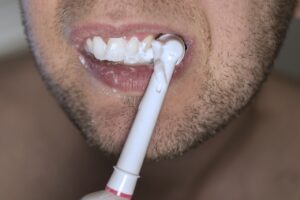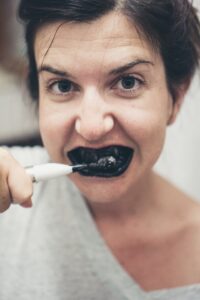Are Instagram Teeth Whitening Products and Trends Safe and Effective?
 Teeth whitening is a multi-billion dollar industry. It is safe to say that pretty much everyone wants to have a bright, white smile. This desire has created a rich market for teeth whitening products and methods. Marketers know the power of social media, and they often use these platforms, like Instagram, to promote a particular teeth whitening product or DIY trend.
Teeth whitening is a multi-billion dollar industry. It is safe to say that pretty much everyone wants to have a bright, white smile. This desire has created a rich market for teeth whitening products and methods. Marketers know the power of social media, and they often use these platforms, like Instagram, to promote a particular teeth whitening product or DIY trend.
When you see an influencer using a specific whitening product or showing off unbelievable results from a homemade teeth whitening “hack”, it is hard to know what to believe. One thing you can certainly trust is this: these influencers are not dentists.
In this week’s blog, we will help you understand the ins and outs of teeth whitening so that you can make good decisions about specific products and trends marketed on Instagram.
What are some Whitening Products Popular on Instagram?
The possibilities seem endless, don’t they? If you search for teeth whitening, you will find more brands of teeth whitening products than you ever dreamed possible. You will see brands you recognize, like Crest, Colgate and Oral B. You may also see brand names that are unfamiliar to you but gaining popularity on Instagram, Snapchat and TikTok. These include Snow, iSmile, Hismile, and BrighterWhite.
Each brand claims some unique ingredient or method that will provide drastic color changes in just a few applications. Many will include small mouthpieces with bright blue lights that supposedly improve your whitening outcome.
The products available include gels, strips, “pens”, and more.
What are some Whitening Trends Popular on Instagram?
Rather than promoting a specific brand-name product, some influencers recommend using a homemade or DIY type of teeth whitening. They typically show before and after pictures of their own teeth that prove the method works.
These methods gain popularity quickly because they are usually very simple and very inexpensive. Often, you can perform these DIY methods with items you already have in your kitchen pantry.
Most of these DIY teeth whitening hacks involve some combination of baking soda, coconut oil, apple cider vinegar, charcoal, and a variety of fruits or fruit juices.
The methods may involve brushing the concoction onto the teeth or swishing it around the mouth.
What Makes a Whitening Technique Safe?
In order for a teeth whitening product or trend to be safe, it must not damage the oral cavity in any way. It cannot include harsh chemicals that would burn or irritate the soft tissues of the gums, lips, cheeks, and tongue.
The pH of the should not be acidic because acids can erode away enamel and its underlying dentin. The technique must not cause any erosion (a chemical wearing away) of hard tooth structures.
A safe whitening technique will not cause any abrasion (a mechanical wearing away of tooth structure). This means that the product or homemade paste cannot be abrasive, like sandpaper.
How Can I Know a Product is Safe?
It is very difficult to determine the safety of a whitening product on your own. The American Dental Association performs safety testing on any product that applies for the “Seal of Approval”. If there is a seal from the ADA on your product, then you can trust that it is safe for use according to the package instructions.
The testing and approval by the American Dental Association means that it will not cause irritation of the soft tissues, erosion or abrasion of the enamel. Many brands elect to perform their own safety testing through independent laboratories. If they do, you can be sure to find that information on their website. You can even contact the lab they used to ask specific questions about a product’s pH or abrasivity. Even better, ask your dentist to look into it!
How Can I Know a Trend is Safe?
 Trends are definitely trickier because you probably use a relatively imprecise method to make a concoction that is not easily evaluated. In general, you must worry about anything acidic, which could lead to erosion, and anything abrasive, which could lead to abrasion.
Trends are definitely trickier because you probably use a relatively imprecise method to make a concoction that is not easily evaluated. In general, you must worry about anything acidic, which could lead to erosion, and anything abrasive, which could lead to abrasion.
You can find out the pH of your ingredients through a quick Google search. For example, if the “recipe” calls for lemon juice, you can simply google “lemon juice pH”. If the pH of any of your ingredients is below 5, then it is acidic enough to damage your hard tooth structures. Fruit juices and vinegars are always very acidic!
Abrasivity is more difficult to discern. If the final product feels more gritty than toothpaste, then it is likely too abrasive to be safe. Again, this is difficult to measure because you may use a wide variety of particles without any standard of size. One example is activated charcoal. Many whitening hacks advise you to use activated charcoal mixed into a toothpaste-like concoction. The varying particle size makes the abrasivity difficult to measure, so it is safest just to avoid any gritty particles.
What Makes a Whitening Technique Effective?
There are, as of now, only two ways to give the teeth a brighter appearance. One is to chemically break down darkly pigmented molecules within the hard tooth structure, which actually changes the tooth’s color. The other is to mechanically polish away superficial stains that exist on the tooth’s outer surface, uncovering the tooth’s natural color. Both will create a whiter smile.
How Can I Know a Product is Effective?
In order for a teeth whitening product to be effective, it must meet two criteria. First, it must contain a hydrogen peroxide chemical or its close relative carbamide peroxide. These are the only compounds capable of penetrating into tooth enamel to oxidize those dark colors underneath. Products claiming to be “peroxide-free” will not actually change your tooth color.
The second necessity for effective teeth whitening is a method of application that keeps the peroxide chemical in contact with the tooth surfaces for a minimum of fifteen to twenty minutes. It takes time for the peroxides to work. This means a quick swish of hydrogen peroxide in your mouth will not produce whiter teeth.
You should look for a produce that contains a peroxide chemical as its active ingredient with a method of keeping the ingredient in contact with the tooth structure for the required length of time.
How Can I Know a Trend is Effective?
 A trend is most likely not going to be effective. Because they contain household ingredients, the proposed mechanism of action is to remove surface stains through either abrasion or absorption (the claims of oil pulling and charcoal use). These claims are unfounded. Oil pulling is perfectly safe (its pH is not acidic, and it is not abrasive at all), but it has nothing that could actually improve the color of the teeth.
A trend is most likely not going to be effective. Because they contain household ingredients, the proposed mechanism of action is to remove surface stains through either abrasion or absorption (the claims of oil pulling and charcoal use). These claims are unfounded. Oil pulling is perfectly safe (its pH is not acidic, and it is not abrasive at all), but it has nothing that could actually improve the color of the teeth.
Baking soda is typically safe, but it is not abrasive enough to polish away surface stains. Most hacks that do involve the use of hydrogen peroxide cannot keep the chemical in contact with the teeth to provide the needed time to affect changes. (Undiluted hydrogen peroxide is irritating to the soft tissues of the mouth if swished for too long, so just holding it in your mouth for longer is not an option!)
More Questions about Teeth Whitening Options?
Call Designer Smiles today to schedule a whitening consultation with Dr. Ann. She can answer any question you have about teeth whitening products and trends and help you choose one that is both safe and effective. Our goal is to help all of our patients have beautiful smiles that they love showing off!
